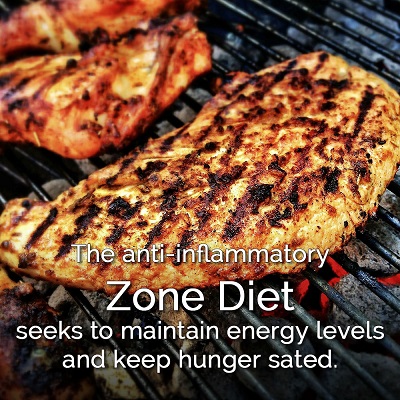 The zone diet is an anti-inflammatory diet created by Dr. Barry Sears who is also the president of the Inflammation Research Foundation in Massachusetts, America. This best-selling diet consists of consuming the lowest number of calories that you can per day whilst still maintaining your energy levels and keeping hunger sated.
The zone diet is an anti-inflammatory diet created by Dr. Barry Sears who is also the president of the Inflammation Research Foundation in Massachusetts, America. This best-selling diet consists of consuming the lowest number of calories that you can per day whilst still maintaining your energy levels and keeping hunger sated.
To achieve results on the zone diet you are required to eat only low levels of monounsaturated and saturated fats, eat only low GI (glycemic index) foods, and consume good amounts of protein to maintain a healthy balance.
This diet is not intended to be a quick-fix diet that promises immediate results of weight loss but a long-lasting one that will help you shed unwanted body fat. This diet can be used as a lifelong meal plan to help you keep the weight off after you have lost it.
This perfectly balanced diet will help you to burn fat, even in your sleep, without losing muscle or water weight. The success of the zone diet is measured by your lack of fatigue and hunger between meals as you need to eat at specific times.
- Within an hour of waking in the morning, you are to eat a well-balanced breakfast.
- During the day you are required to eat every 5 hours to keep hunger at bay and help to burn fat.
- A light snack before bedtime is also required.
You will need to stick to the rules if you are to succeed on this diet. You are required to consume 30% protein, 30% fat and 40% carbohydrates at every meal and snack time.
To get a better visual of what that looks like on a plate a typical serving is equivalent to one palm-size portion of protein, a dash of olive oil, and two-thirds of the plate filled with non-starchy vegetables or fruits.
Calories are counted in this diet. For women, the zone diet requires you to eat approximately 1200 calories per day. For men, the average target is 1500 calories per day.
On the zone diet, you are allowed to eat all foods as nothing is completely off-limits, although it is important to remember whatever you are eating is going to affect your dieting, and ultimately add fat to your body that will need to be dieted or worked off.
If you like to consume carbohydrate foods you will find this diet challenging as it restricts the amount of carbs you are allowed to eat. Foods high in starch and bread and grains are to be used as small sides and not the basis of your meals.
The recommended amount of main meals per day is 3 with 2 snacks, usually one in the afternoon and another before bedtime. Of high importance is ensuring that you keep the 30-30-40 (protein, fat, carbohydrates) rule in mind for all meals including snacks.
The following are suggested food options for the 30-30-40 portions.
Fats – The fats that are suggested to be eaten are good, heart-healthy fats which can include foods like avocado, olive oils, chia seeds and salmon for omega 3’s.
Protein – The best protein-rich foods in this diet include skinless and low-fat meats like chicken, turkey and fish as well as tofu, eggs, and dairy products.
Fruits and vegetables – At least 10 serves of fruit and vegetables are recommended in the zone diet and it is recommended that most of your carbohydrates come from these sources.
The reasoning behind the 10 serves is because of the high count of polyphenol which is a naturally occurring plant-based chemical that reduces inflammation in the body.
These mostly come from vibrantly colored fruits and vegetables. Low GI (glycemic index) fruits and vegetables are also better for you as they will help to balance your glucose levels and not cause a sugar rush or spike in blood sugar levels. A few high-GI options to avoid include potatoes, mangoes and corn.
Grains and starches – Foods containing grains and starches are to be limited and only eaten sparingly. Any refined grains like white bread are to be substituted with wholegrain options when possible. Some foods in this category that are allowed regularly include barley and oats.
Exercise is also a large part of this diet to help with both reducing inflammation and burning fat. Moderate exercise is required, with targets being approximately 30 minutes a day of brisk walking, swimming or aerobatics as well as around 10 mins of strength training.
This diet is not recommended for people with pre-existing health issues, especially kidney-related. Always consult a healthcare professional before starting a new diet or strenuous exercise.






